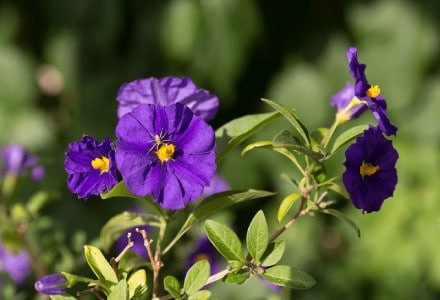
Nightshade Facts
- Most notably, the word Nightshade serves as the common name for an extremely large Family of remarkable flowering plants. In point of fact, this incredible group actually holds a huge number of separate but closely related species.
- That holds true because of the fact that, currently, more than 2,700 known species exist within this large Family. These further fall within an impressive total of 98 genera. Surprisingly, many members of this Family have important uses in some cultures.
- These cultural uses of Nightshade include such varied roles as ornamental plants, spices, and medicinal plants. However, the fascinating Nightshade remains best known for the fact that some of the varieties evolved to be extremely toxic.
- This often leads to the mistaken belief that all plants bearing the name evolved as toxic. In fact, nothing could be further from the truth. Being also known as Solanaceae, many types of Nightshade serve as commonly grown crops for agriculture.
- These crop plants include such highly diverse food crops as potatoes, tomatoes, eggplant, peppers, and even tobacco. But the group nonetheless also contains many species known for their beauty. This includes flowers such as the petunia.
Related Articles
Rosy Periwinkle Orpheus Flower Rosary Pea
Nightshade Physical Description
Since the name of Nightshade applies to such an incredible quantity of species, differences quite naturally exist among them. This also includes physical descriptions. Nevertheless, the simple fact of their relationship means that some share certain physical traits.
Firstly, all members of this group of plants evolved as either of two specific types of plants. This holds true since every plant within this grouping develops as either a variety of an upright plant or, more commonly, some type of ground-hugging foliage, and quite long.
Secondly, the differing examples of Nightshade all have another mutual trait. Over the course of time, each of them evolved to produce tubers. Thirdly, another shared trait is that of herbaceous foliage that displays either a tough leathery nature, or formidable spines.
The flowers of most of these astonishingly varied species further develop as hermaphroditic in nature. Some of them nonetheless do develop as monoecious or dioecious. The blooms of the plant may also appear as either individuals or in large groups.
Finally, the fruit earns its own attention. In point of fact, the fruit also takes a variety of forms, understandably depending upon the species. Most commonly, though, this part of the plant develops in the form of a comparatively quite small berry.
- Kingdom: Plantae
- Phylum: Magnoliophyta
- Class: Magnoilopsida
- Order: Solanales
- Family: Solanaceae
Nightshade Distribution, Habitat, and Ecology
Since the collective term Nightshade applies to such an enormous number of species, its total range comes as no surprise. That’s because the various species within this Family inhabit every continent in the world, except for the frigid Antarctica.
The greatest concentration, of both separate species, and individual specimens, occurs across Central America, and throughout much of South America. The sheer diversity of plants results in varying forms of Nightshade inhabiting many diverse types of ecosystems.
This range of habitat types includes both temperate and tropical forests, as well as open meadows, and even some arid and semi-arid desert regions. But, the greater percentage of species and individuals appears in the portions of its range with tropical climates.
These extraordinary plants never fail to impress with their versatility and adaptability. That’s partly because it commonly occurs either as an annual or perennial herb. In addition to this, these awesome plants can also develop as a vine, liana, shrub, tree, or epiphytic.
Finally, many of these varieties also comprise important agricultural crops. This holds especially true in certain regions of the world. But, the alkaloids prevalent in some kinds of Nightshade nevertheless do render them too toxic for such use.
Species Sharing Its Range
Bald Uakari Hooker’s Lips Calleta silkmoth
Check out our other articles on Magnificent Mammals of Australia, Pocket Shark, McMurdo Dry Valleys, Inaccessible Island Rail, Long-Finned Pilot Whale, Loggerhead Sea Turtle

